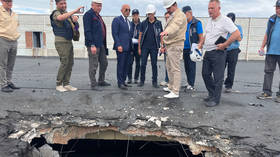UN team issues report on under-fire Ukrainian nuclear site

The International Atomic Energy Agency (IAEA) has called for an end to all military activity around the Zaporozhye Nuclear Power Plant and insisted that shelling in the area must stop. The agency’s report on the situation in Ukraine, published on Tuesday, stopped short of identifying the culprits targeting the Russian-held facility.
“Any military activity – such as shelling – within, or in the vicinity of, a nuclear facility has the potential to cause an unacceptable radiological consequence,” the IAEA report said, adding that the “seven pillars” of nuclear safety “have all been compromised at the site.”
“The IAEA recommends that shelling on site and in its vicinity should be stopped immediately to avoid any further damages to the plant and associated facilities, for the safety of the operating staff and to maintain the physical integrity to support safe and secure operation,” the agency said, adding that this would require “agreement by all relevant parties to the establishment of a nuclear safety and security protection zone around the ZNPP.”
Zaporozhye is Europe’s largest nuclear power plant. Along with the nearby city of Energodar, it has been under Russian control since March. Artillery, drone, and rocket attacks began in July, however, damaging cooling systems, power lines, and other facilities.
The Russian military has named the specific Ukrainian artillery units carrying out the attacks and provided their locations to the UN. Kiev has accused Moscow of using the plant as a base for heavy artillery and equipment, but also denied responsibility for the shelling, calling it a Russian false-flag operation to make Ukraine look bad.
Last week, however, the Ukrainian General Staff admitted to targeting Energodar and claimed that all Russian “military equipment” had been relocated from the ZNPP ahead of the IAEA’s visit. The inspectors contradicted this, saying they had observed Russian “military personnel, vehicles and equipment at various places at the ZNPP,” providing security.
Kiev and its Western backers had previously demanded the establishment of a 30-kilometer demilitarized zone around the Zaporozhye NPP, but Moscow rejected this as unacceptable, pointing to continued Ukrainian artillery attacks on the site.
IAEA Director General Rafael Grossi personally led the mission to Zaporozhye, dubbed ISAMZ, on September 2. The facility came under artillery attack during the visit, while Ukrainian commandos attempted to seize the plant after crossing the Kakhovka Reservoir by boat, according to the Russian Defense Ministry.













